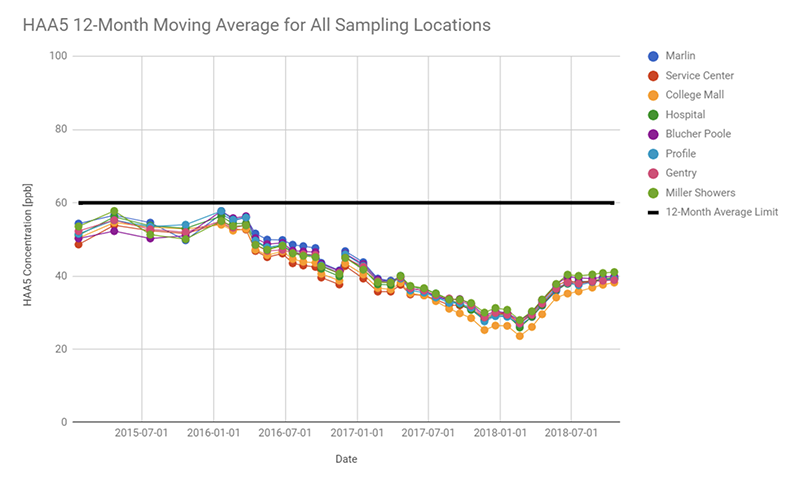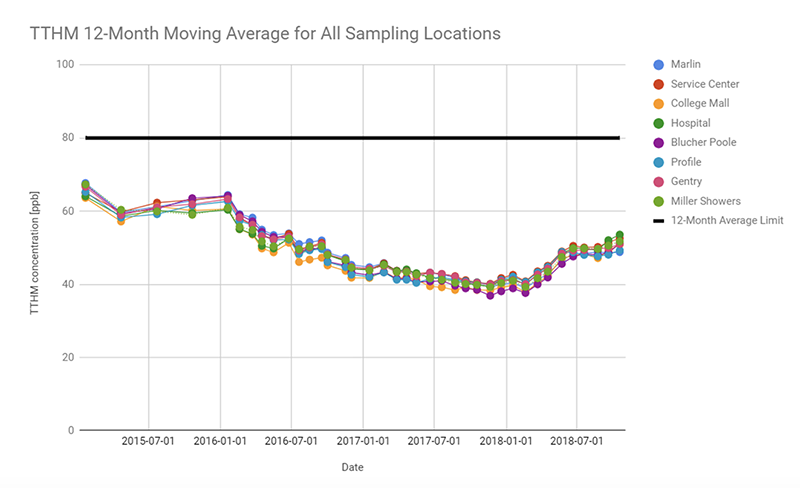Page last updated on April 7, 2025 at 2:50 pm
Although water quality was meeting or exceeding all federal and state standards, disinfection byproducts (DBPs) were a major concern of the community when Mayor Hamilton came into office in January of 2016. DBPs are the result of certain disinfectants, including chlorine, interacting with organic matter, such as leaves or algae from Lake Monroe. The maximum limits set by environmental regulatory agencies are based on annual moving averages for the system. Those never exceeded the limits, but individual sampling sites were above that threshold, and the averages were outside the City of Bloomington Utilities’ (CBU) comfort zone. In fact, CBU had hit a threshold level twice between 2013 and 2015 that had triggered a requirement that the city submit an operational plan to the U.S. Environmental Protection Agency and the Indiana Department of Environmental Management (IDEM).
Excessive levels of DBPs in drinking water have been linked to an increased risk of cancer, and short-term exposure can be an issue for vulnerable populations, such as the elderly, pregnant women, infants, and those with compromised immune systems.
Believing that providing safe drinking water to all of our customers is mandatory, Mayor Hamilton set forth a plan to greatly decrease the amount of DBPs.
The city contracted with Lochmueller Group in addition to its current contract with Black and Veatch to have a second set of eyes on the issue. The cost of that agreement was less than $75,000.
The Utilities Department increased the pipe flushing program to improve and maintain water quality throughout the system.
The city increased staffing to improve infrastructure and moved from quarterly to monthly testing for DBPs.
Placed information on the DBPs and monthly testing results on “B Clear,” the City’s data portal.
Because of our great team at Utilities, DBP levels have been dramatically reduced to well under the limits set by the Environmental Protection Agency and IDEM. In addition, CBU is in the middle of major upgrades of their water, wastewater, and stormwater infrastructure to assure top quality systems for us all for decades to come.


Disinfectant Byproduct Reduction Initiative Timeline
August 17, 2018
City of Bloomington Officials Report July 2018 Disinfection Byproduct Levels
July 23, 2018
City of Bloomington Officials Report Second Quarter 2018 Disinfection Byproduct Levels
June 9, 2017
City of Bloomington Officials Report Decline In Disinfectant Byproduct Levels
May 4, 2017
City of Bloomington Utilities Report April's Disinfectant Byproduct Levels
April 7, 2017
City of Bloomington Officials Report Decline In Disinfectant Byproduct Levels
March 10, 2017
City of Bloomington Officials Report February 2017 Disinfection Byproduct Levels
February 9, 2017
City of Bloomington Officials Report January 2017 Disinfection Byproduct Levels and New Water Treatment Plant Superintendent
January 26, 2017
City of Bloomington Officials Report December 2016 Disinfectant Byproduct Levels
December 29, 2016
City of Bloomington Officials Report November 2016 Disinfectant Byproduct Levels and New Water Treatment Plant Superintendent
November 29, 2016
City of Bloomington Officials Report October 2016 Disinfectant Byproduct Levels and New Water Treatment Plant Superintendent
October 17, 2016
City of Bloomington Officials Report September 2016 Disinfectant Byproduct Levels
September 22, 2016
City of Bloomington Officials Report Decline in August 2016 Disinfectant Byproduct Levels
August 18, 2016
City of Bloomington Officials Report Decline in July 2016 Disinfectant Byproduct Levels
July 19, 2016
City of Bloomington Officials Report June 2016 Disinfectant Byproduct Levels
May 5, 2016
Monthly Water Testing Results Announced
March 18, 2016
Bloomington Water Quality Test Results In For February
January 14, 2016
Mayor Hamilton Provides Information on Water Quality
